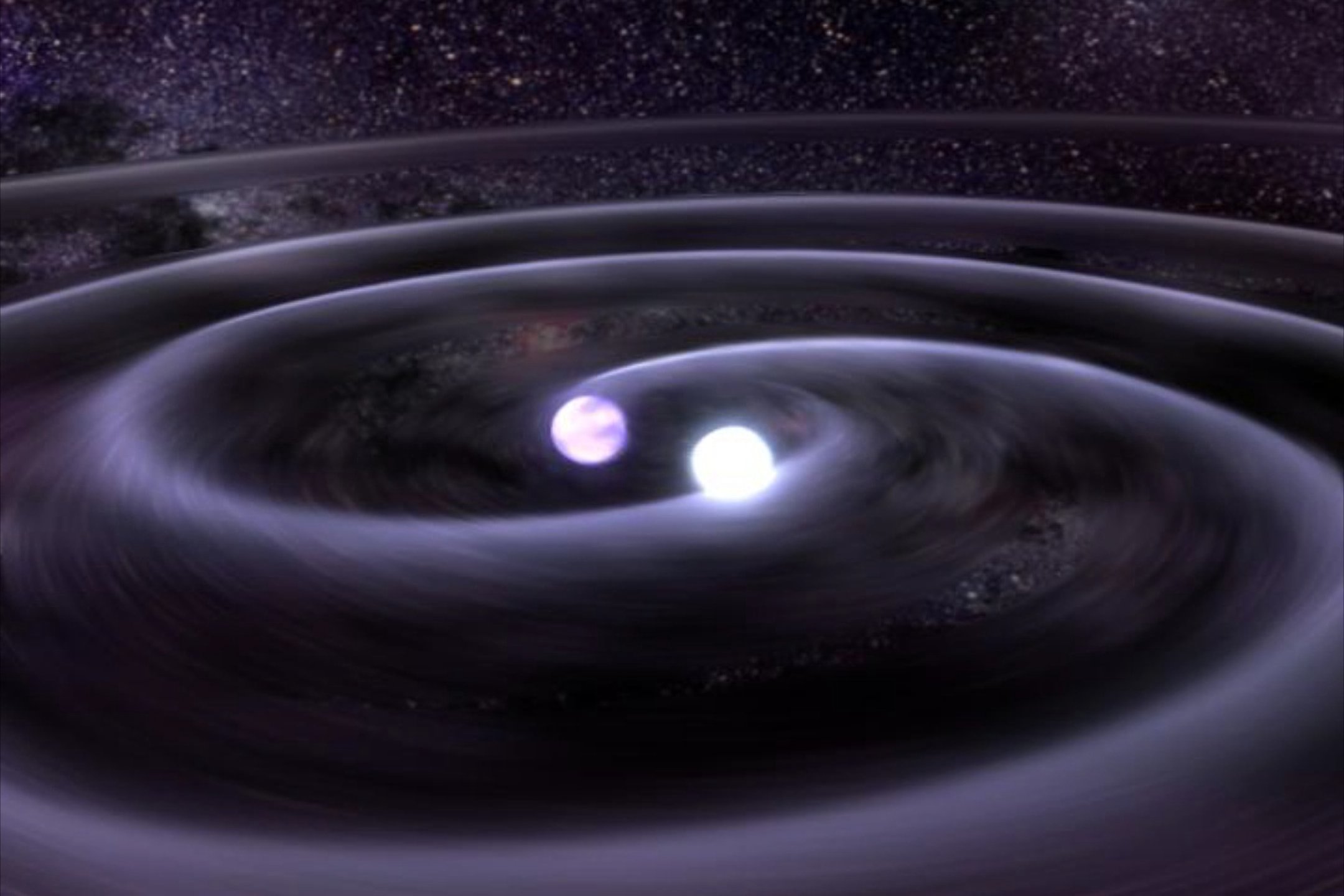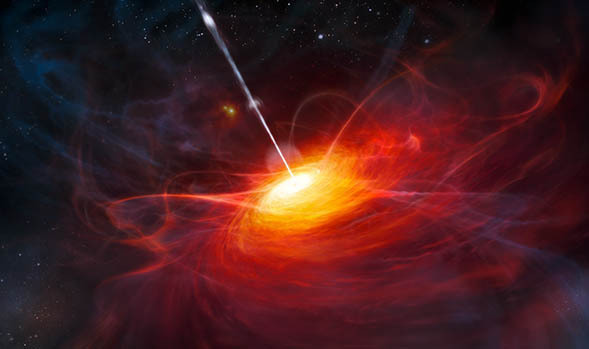Gamma-ray bursts
Article curated by Ed Trollope
Gamma-ray bursts are short, powerful blasts of gamma-ray radiation, which originate in deep space. Some are believed to be caused by an exploding star (a supernova), while others may be due to neutron stars colliding. Gamma-ray bursts are often created by events very far away; it may have taken the burst so long to reach the Earth that it occurred billions of years ago in the early universe. In fact, there's a lot about that time that we don't yet know, and gamma-ray bursts are one of our best tools for investigating. Gamma-ray bursts might even help us learn more about how the star formation rate has changed throughout the ages.

Long- and Short-GRBs
Most gamma-ray bursts last just a matter of seconds, but some last far longer. In general, these "long" GRBs are thought to be formed when a massive star reaches the end of its life. Accompanying these we expect to see a supernova – assuming the GRBs aren't too distant (the supernova part is much fainter). However, there are some apparently long GRBs which, despite being nearby, do not seem to have an accompanying supernova, e.g. GRB 060614 (so-named because it was observed on 14 June 2006)[1] – why is unknown.


We think short gamma-ray bursts, which come from areas of the galaxy with lower star formation rates, are formed when two neutron stars in a binary system merge[2].
Scientists expect gravitational waves to be emitted as this happens, and on 17th August 2017, this seems to have been confirmed when a GRB (designated GRB 170817A) was detected by NASA's Fermi space telescope – and, simultaneously, LIGO detected a gravitational wave (designated GRB 170817)[3]. Professor Nial Tanvir from the University of Leicester commented at the time I find it amazing to think that all the gold in the Earth was probably produced by merging neutron stars, similar to this one, that exploded as kilonovae billions of years ago
. But answers often lead to more questions, and this observation was no different. As scientists analysing the data from the Swift space telescope noted[4]: the discovery represents the start of a new era of multi-messenger astronomy
, but that the connection to classical short GRBs remains unclear
.


There are also some gamma-ray bursts (with associated supernovae) which show unusual curvature in their X-ray spectra, and which can be modelled using blackbodies. This was first clearly seen in GRB 060218[5] and, at the time, was thought to be the shock-breakout of the supernova. However, the energetics are not completely understood. To explain them, scientists suspect the systems contain jets; if the energy were emitted equally in all directions, it would mean so much energy was released that we couldn't explain it at all!


Other GRBs we might expect to see are missing. For example, we would expect to detect gamma rays indicating a big local supernova roughly every 3 to 4 years – but haven't seen any for the last 10! Since our gamma and hard X-ray telescopes observation power has increased, we could learn so much more from these events were they to occur again (cobalt and nickel are produced very quickly during a supernova and how soon you see their spectral lines can tell astronomers properties about the nucleosynthesis mechanisms within the supernova and how fast the burning front moves through the star) – but either they haven't, or we haven't detected them. Astronomers are unable to explain the absence of data.

Cosmic Jets

Although researchers are not clear as to exactly what causes these jets, their focus tends to be on the central body – such as a black hole – or the surrounding accretion disc.
Learn more about Cosmic Jets.


Fast radio bursts that lasted for 4 milliseconds have been detected from 5.5-10.4 billion light-years away. Weirdly, no associated gamma, X-ray, optical or gravitational wave signatures were detected with the burst, and there were no repeat events. Scientists think this points to a cataclysmic source, which could be soft gamma-ray repeaters or core-collapse supernova (ccSN) orbiting neutron stars.

High-energy neutrinos may originate from high energy cosmic events and, as such, could provide information on objects such as black holes and gamma-ray bursts. They interact only weakly with matter, and so pass straight through bodies such as the earth and are unperturbed by gravity. The IceCube Neutrino Observatory recently claimed to have detected such neutrinos, although their results ares unconfirmed and, if so, what they can tell us.

 2
2Radiation Risk in Space

Gamma-ray bursts may be very useful and interesting to us, but are they dangerous?
The Earth's magnetic field protects us from radiation, but the environment outside of our magnetosphere is exposed.
Radiation can have a negative impact upon human health, causing damage to DNA, damage to cells and potentially cancer, but quantifying the risk posed by this radiation outside the Earth’s magnetic field isn’t easy – there are lots of factors involved. For example, the intensity and energy distribution of incoming particles of the radiation depend upon the present behaviour of the solar wind, which remains poorly understood. The actual risk from radiation with different levels of energy is also not fully established, and experiments into this are ongoing both on earth and in space.


 2
2This article was written by the Things We Don’t Know editorial team, with contributions from Kim Page, Jon Cheyne, Cait Percy, and Johanna Blee.
This article was first published on 2015-08-27 and was last updated on 2019-07-24.
References
why don’t all references have links?
[1] Mangano, V., et al., (2007) Swift observations of GRB 060614: an anomalous burst with a well behaved afterglow Astronomy & Astrophysics 470.1:105-118 doi: 10.1051/0004-6361:20077232.
[2] Gehrels, N., et al., (2005) A short gamma-ray burst apparently asssociated with an elliptical galaxy at redshift z=0.225 Nature 437:851-854 doi: 10.1038/nature04142.
[3] Abbott, B., et al., (2017) GW170817: Observation of Gravitational Waves from a Binary Neutron Star Inspiral Physical Review Letters 119(16) doi: 10.1103/PhysRevLett.119.161101.
[4] Evans, P,A., et al., (2017) and observations of GW170817: Detection of a blue kilonova Science 358(6370):1565-1570 doi: 10.1126/science.aap9580.
[5] Campana, S., et al., (2006) The shock break-out of GRB 060218/SN 2006aj Nature 442:1008-1010 doi: 10.1038/nature04892.
Blog posts about gamma-ray bursts

Recent gamma-ray bursts News
Get customised news updates on your homepage by subscribing to articles












